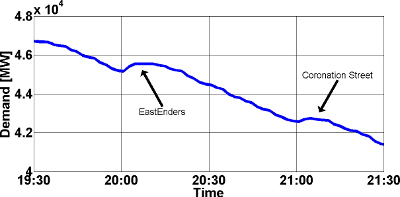Further Details
Contents
Demand Pickups

A typical TV demand pickup for a Thursday evening. After EastEnders finishes at 20:00, a spike of around 200MW occurs as viewers perhaps switch their kettles
on for a cup of tea. Later on, Coronation Street finishes at 21:00 and shortly afterwards a similar but smaller spike occurs.
Data source: National Grid
Dynamic Demand Control
Dynamic demand control (or management) is a technique designed to adjust appliance power requirements in response to the availability of electricity on the grid. Such devices usually have a means of sensing the National Grid's frequency, which serves as an indication as to whether there is too much or too little power being produced to meet demand. A dynamic demand controlled appliance would attempt to lower its electricity usage in times when the grid is at a supply deficit, and correspondingly increase its usage in times when the grid is at a supply surplus. Careful dynamic demand control would result in the appliance not using any more or less electricity than it would otherwise, but it has positive consequences for the stability of the electricity grid as a whole.
Currently, the use of this technology is centred around home and business appliances, such as refrigerators. However, studies have also been conducted into the possibility of using the technology for electric cars.[3] Some systems even propose using electric cars as electricity supplies, releasing power back into the grid when required, leaving enough stored for the owner’s own usage.[4]
Dynamic Demand Fridge
One such concept is the dynamic demand refrigerator. Refrigerators with built-in controllers monitoring the grid frequency in order to decide when to initiate refrigeration have been tested and have shown positive results.[5] Fridges typically have two threshold temperatures: one temperature above which the fridge will turn on its compressor to cool the contents, and another temperature below which the fridge will turn off its compressor to stop cooling the contents too much. Smart fridges scale these threshold temperatures by the inverse of the grid frequency, such that periods of grid supply deficit (when the grid frequency is less than 50 Hz) increase the temperature at which they start to cool the contents. Typically, these fridges can maintain the internal temperature within safe limits for up to an hour before being forced to switch back on again regardless of the state of the grid. This window gives the National Grid controllers some time in which to get reserve power systems online. If every fridge in the UK (estimated to be around 40 million[6]) were to use this kind of technology, savings of between 500MW[7] (roughly equivalent to a typical nuclear fission reactor’s power output) and 1200MW[6] could be achieved for up to an hour at short notice.
The use of this technology for companies that heavily utilise refrigeration, such as supermarkets, can lead to money being saved with the negotiation of special electricity supply contracts involving smart meters. Energy use can be monitored, and energy used when the National Grid is running at a surplus can be sold at a reduced tariff. For example, the supermarket Sainsbury's has recently started introducing the technology into some of its fridges.
Random Walk Algorithm
The solar data within the dataset was generated using a number of techniques built upon a random walk algorithm. This involved choosing a random direction for the atmospheric attenuation factor to 'walk', or in other words, a random change either up towards 1 or down towards 0.
While the direction chosen was pseudorandom and so equally probable of being either 'up' or 'down', the actual step size taken after the direction has been decided was chosen as a random number falling within a specific type of distribution. This meant that the step size, while a random value, favoured specific ranges of values more than others. The specific distribution used was a Gaussian (normal) centred around 0, with a standard deviation of 0.1589. The Gaussian technique and these values were chosen in order to reproduce as accurately as possible the rate of change of attenuation of the real Met Office sensor data. This meant that not only would the simulated 'cloudiness' resemble reality, but also the rate at which clouds come and go.
Footnotes
- Janet Ramage, Godfrey Boyle. Energy Systems and Sustainability: Power for the Sustainable Future, Oxford University Press, 2011. ISBN: 9780199593743.
- Godfrey Boyle. Renewable Energy: Power for a Sustainable Future, Oxford University Press, 2012. ISBN: 9780199545339.
- Chang-Yu Huang, J.T. Boys, G.A. Covic, J.R. Lee, and R.V. Stebbing. Implementation and Evaluation of an IPT Battery Charging System in assisting Grid Frequency Stabilisation through Dynamic Demand Control. In Vehicle Power and Propulsion Conference (VPPC), IEEE, 2010, pages 1–6, September 2010. DOI: 10.1109/VPPC.2010.5729207.
- M. Ifland, N. Exner, and D. Westermann. Appliance of Direct and Indirect Demand Side Management. In Energytech, IEEE, 2011, pages 1–6, May 2011. DOI: 10.1109/EnergyTech.2011.5948534.
- Short, J.A.; Infield, D.G.; Freris, L.L., "Stabilization of Grid Frequency Through Dynamic Demand Control," Power Systems, IEEE Transactions on, vol.22, no.3, pp.1284-1293, Aug. 2007. DOI: 10.1109/TPWRS.2007.901489.
- Department of Energy and Climate Change. The Potential for Dynamic Demand. Technical report, Department of Energy and Climate Change, November 2008. URN 08/1453. (This doesn't appear to be available on the DECC's website any more. However, a copy can be found hosted here as of 09/09/12.)
- National Grid plc. Operating the Electricity Transmission Networks in 2020. Technical report, June 2009.
